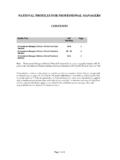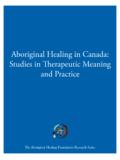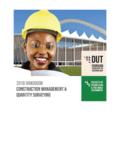Transcription of Interagency Guidelines For Professional Staff 2012
1 Interagency Guidelines For Professional Staff 2012. 1 UPDATED 2012. NEXT UPDATE 2014. Foreword These inter-agency child protection Guidelines , prepared by the Angus Child Protection Committee, have been reviewed to take account of a number of recent legislative, policy and practice developments. Online safety, child trafficking and the protection of children affected by parental alcohol and/or drug misuse are only some of the specific issues that have become the focus of attention in recent times. One of the more fundamental developments, however, has been the move towards children's services that put the interests of the child at the centre of every process and decision, building up from universal services: the Getting it Right for Every Child (GIRFEC) approach has been instrumental in this.
2 The welfare and protection of children and young people is everyone's job and everyone's responsibility. The responsibility to achieve this lies with parents and carers and all agencies involved in the protection of children both directly or indirectly. Professional Staff require skills and sensitivity of a high order if children at risk are to be protected. It is recognised that Staff require the support of their own and other agencies to ensure that any intervention in a child's life is purposeful and effective and has the welfare of the child as the paramount consideration. These updated Guidelines are designed to aid and promote multi-agency co-operation in protecting children from harm and are intended to help make services relevant and appropriate to the child's needs and to ensure that children are protected.
3 The focus of service delivery must be: On ensuring services address children's needs before difficulties escalate into harm to the child; and On ensuring appropriate and effective responses to all children where concerns exist for their safety and protection. The Children's Charter sets out what children and young people need and expect to help protect them when they are in danger of being or already have been harmed by another person. Within the Charter children state; As children and young people, we have a right to be protected and safe from harm from others. When we have difficulties or problems we expect you to: Get to know us Speak with us Listen to us Take us seriously Involve us Respect our privacy Be responsible to us Think about our lives as a whole Think carefully about how to use Put us in touch with the right people information about us Use your power to help Make things happen when they should Help us be safe.
4 These are messages to all of us. Tim Armstrong, Chairperson Angus Child Protection Committee 2 UPDATED 2012. NEXT UPDATE 2014. How to Use these Guidelines These Guidelines have been produced to support, reflect and translate the National Guidance for Child Protection in Scotland 2010 into the Angus child protection working context/arrangements. These Guidelines do not replace the National Guidance for Child Protection in Scotland 2010, nor do they replace any existing single service/agency child protection policies, procedures and/or Guidelines . On the contrary, they aim to support them and provide the over-arching policy framework, within which all other child protection policies, procedures and/or Guidelines should fall. These Guidelines are divided into nine parts: Part 1 The context for child protection describes the policy and legislative framework which underpins child protection policy and practice in Scotland and locally in Angus and outlines key definitions, concepts and terminology within child protection processes.
5 Part 2 Roles and Responsibilities provides information on the profiles of the various partnerships, services/agencies involved in local child protection arrangements. Part 3 Identifying and responding to concerns provides a glossary of definitions currently used in child protection and includes useful checklists on indicative signs and symptoms of potential harm and abuse, including what to do if you are worried about a child. Part 4 - Joint Investigations Police, Social Work and Health provides an outline of the key component processes for child protection concerns; investigation and response;. information sharing; risk assessment; interviewing and medical examinations. Part 5 - Child Protection Case Conferences and Core Groups provides an outline of the processes for child protection case conferences and core group meetings.
6 Part 6 Child Protection Register describes the purpose and processes of the child protection register and placing and removal of children from the register. Part 7 - Child Protection Special Circumstances provides information and advice on a range of other key child protection issues which practitioners may identify and/or become involved in. This is not an all inclusive or exhaustive list of issues. Part 8 - Interagency Protocols and Guidance of all the Angus Child Protection Committee protocols are helpfully listed in this section. Part 9 - Appendices Throughout these Guidelines , practitioners will find helpful electronic links for quick and easy reference to other key documents. These Guidelines are available and maintained as an online electronic resource on the Angus Child Protection Website.
7 3 UPDATED 2012. NEXT UPDATE 2014. Contents Part 1 THE CONTEXT FOR CHILD PROTECTION. Introduction Principles And Standards For Child Protection Policy Context Legislative Framework Relating To Child Protection Key Definitions And Concepts Part 2 ROLES AND RESPONSIBILITIES FOR CHILD PROTECTION. Introduction Angus Council Social Work And Health Tayside Police Medical Staff Education Staff Housing Staff Leisure Services The Armed Services Faith Organisations Voluntary Organisations/Third Sector Early Years Providers Scottish Children's Reporter Administration Agencies' Responsibilities To Share Information About Children's Hearings And Supervision Requirements The Procurator Fiscal Requirements Of Evidence Specialist Advice Or Expertise Withscotland The University Of Edinburgh/NSPCC Centre For UK-Wide Learning In Child Protection (CLICP).
8 Angus Joint Executive Group For Child/Adult Protection/Public Protection. The Angus Child Protection Committee Part 3 IDENTIFYING AND RESPONDING TO CONCERNS ABOUT CHILDREN. Identifying And Managing Risk What Is Child Abuse And Neglect What Is Child Protection? Recognising Actual Or Potential Harm Signs And Symptoms Information Sharing And Recording Identifying And Managing Risk Responding To Concerns About Children Or Young People Reporting A Concern Initial Screening And Information Gathering Outcome Of Child Protection Enquiries Repeated Referral/Concerns Seeking Information About Children And Families Who Have Lived Abroad Managing Disagreements Child Protection Referrals/Notification To The Care Commission 4 UPDATED 2012. NEXT UPDATE 2014. Part 4 JOINT INVESTIGATIONS POLICE, SOCIAL WORK AND HEALTH.
9 Planning A Child Protection Investigation Abused By Organised Networks And/Or Multiple Victims Or Perpetrators Joint Investigation/Assessment Medical Examination And Health Assessment Consent To Medical Treatment And Examination Psychiatric Or Psychological Examinations Debriefing Counselling And Criminal Proceedings Meetings To Support Children And Their Families Part 5 CHILD PROTECTION CASE CONFERENCES AND CORE GROUPS. Child Protection Case Conferences (CPCCs). Child Protection Plan Core Groups Assessment And Plans To Protect The Child Part 6 CHILD PROTECTION REGISTER. Introduction The Aims Of The Child Protection Register Availability Of The Child Protection Register Placing A Child On The CPR. Conviction Or Finding At Proof Direct Communication With The Registered Child Removing A Child From The Child Protection Register Child Protection Messaging Transfer Of Cases When Child's Name Is On The Child Protection Register Part 7 CHILD PROTECTION SPECIAL CIRCUMSTANCES.
10 Introduction Violence Against Women (Domestic Abuse). Children Affected By Parental Substance Misuse (CAPSM). Children And Young People Affected By Parental Mental Health Children And Young People Experiencing Mental Health Problems Children Affected By Disability Children And Young People At Risk Of Self Harm And/Or Suicide Underage Sexual Activity Children And Young People Who Are Missing And/Or Young Runaways. Child Trafficking Honour Based Violence Female Genital Mutilation Bullying Online and Mobile Phone Child Safety Lesbian, Gay, Bisexual, Transgender young people (LGBT). Non engaging families Children Who Are Looked After Away From Home 5 UPDATED 2012. NEXT UPDATE 2014. Children in Foster Homes Regulated Care Services Allegations Against Members of Staff (Including Residential Care Staff ).





